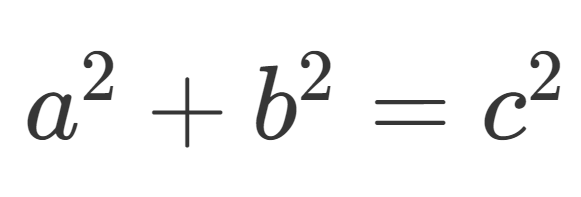Given the triangle ABC, find the length BC
Given the triangle ABC, find the length BC
Look at the triangle in the diagram. How long is side BC?
What is the length of the side marked X?
Calculate the perimeter of the rectangle ABCD.
Look at the following rectangle:
AB = 12
AC = 13
Calculate the area of the triangle BCD.
Given the triangle ABC, find the length BC
To answer this question, we must know the Pythagorean Theorem

The theorem allows us to calculate the sides of a right triangle.
We identify the sides:
ab = a = 5
bc = b = ?
ac = c = 13
We replace the data in the exercise:
5²+?² = 13²
We swap the sections
?²=13²-5²
?²=169-25
?²=144
?=12
12 cm
Look at the triangle in the diagram. How long is side BC?
To solve the exercise, it is necessary to know the Pythagorean Theorem:
A²+B²=C²
We replace the known data:
2²+B²=7²
4+B²=49
We input into the formula:
B²=49-4
B²=45
We find the root
B=√45
This is the solution. However, we can simplify the root a bit more.
First, let's break it down into prime numbers:
B=√(9*5)
We use the property of roots in multiplication:
B=√9*√5
B=3√5
This is the solution!
cm
What is the length of the side marked X?
We use the Pythagorean theorem:
Calculate the perimeter of the rectangle ABCD.
Let's focus on triangle BCD in order to find side BC.
We'll use the Pythagorean theorem using our values:
Let's now remove the square root:
Since each pair of opposite sides are equal to each other in a rectangle, we can state that:
Now we can calculate the perimeter of the rectangle by adding all sides together:
62
Look at the following rectangle:
AB = 12
AC = 13
Calculate the area of the triangle BCD.
To solve this problem, we'll follow these steps:
Step 1: Given and , we use the Pythagorean Theorem to find .
Step 2: Knowing the sides (height of the rectangle) and (base of the rectangle), triangle will have the base and the height .
The area of triangle is:
Therefore, the area of triangle is 30.
30
Look at the triangle in the figure.
What is the length of the hypotenuse given that its perimeter is \( 12+4\sqrt{5} \) cm?
Look at the triangle in the figure.
What is the length of the hypotenuse given that its perimeter is cm?
We calculate the perimeter of the triangle:
As we want to find the hypotenuse (BC), we isolate it:
Then calculate AC using the Pythagorean theorem:
We then simplify the two:
We simplify to obtain:
Now we can replace AC with the value we found for BC:
cm